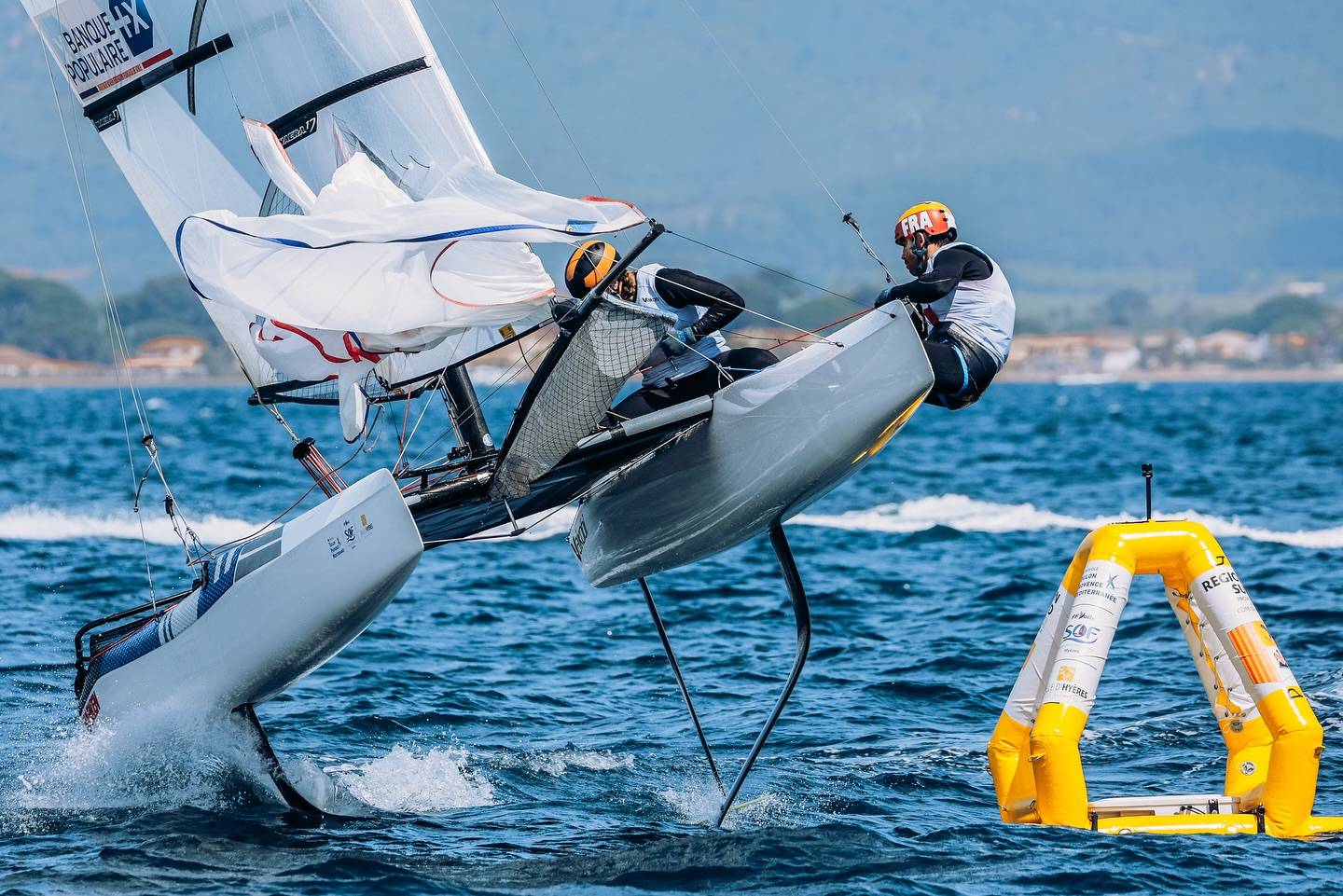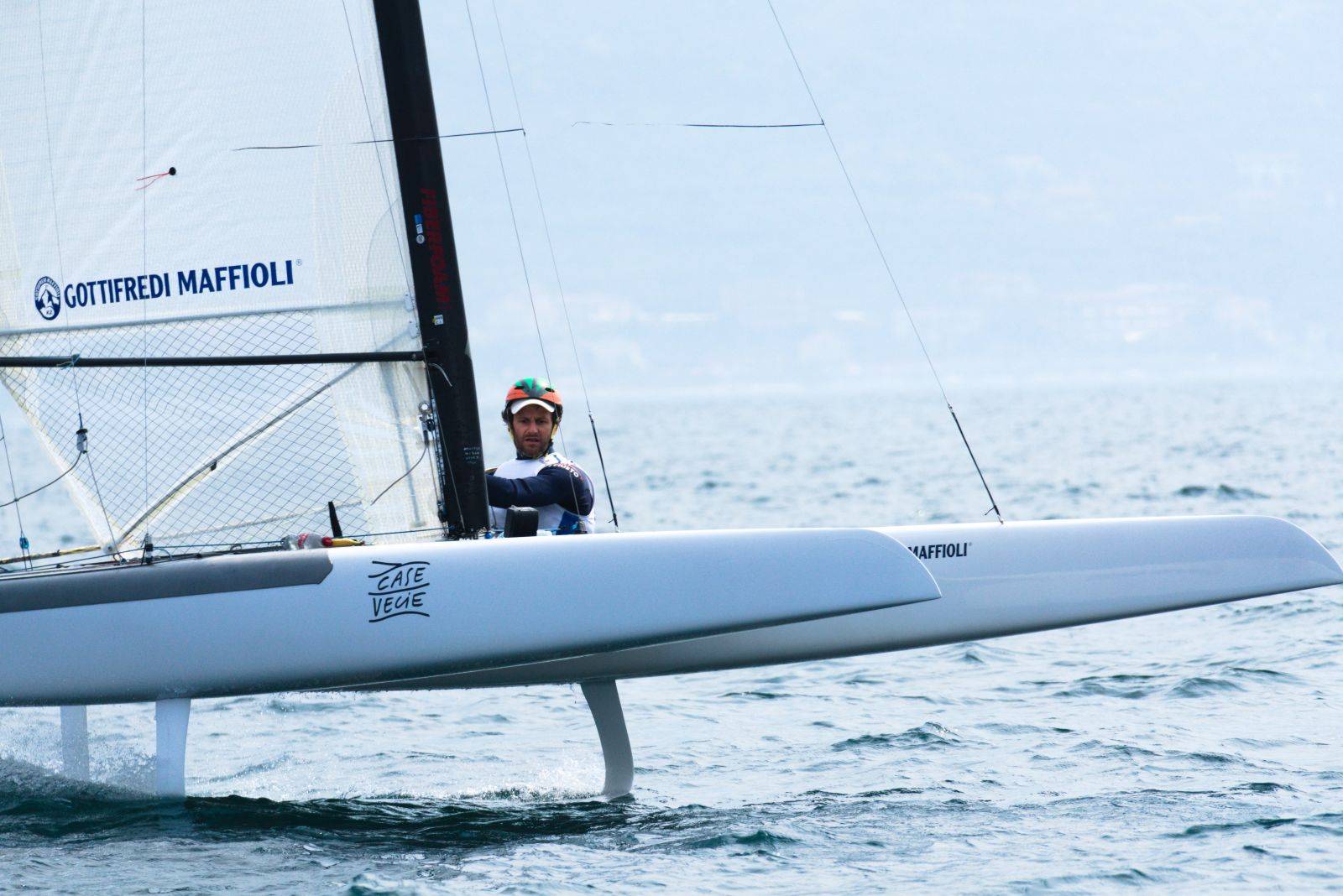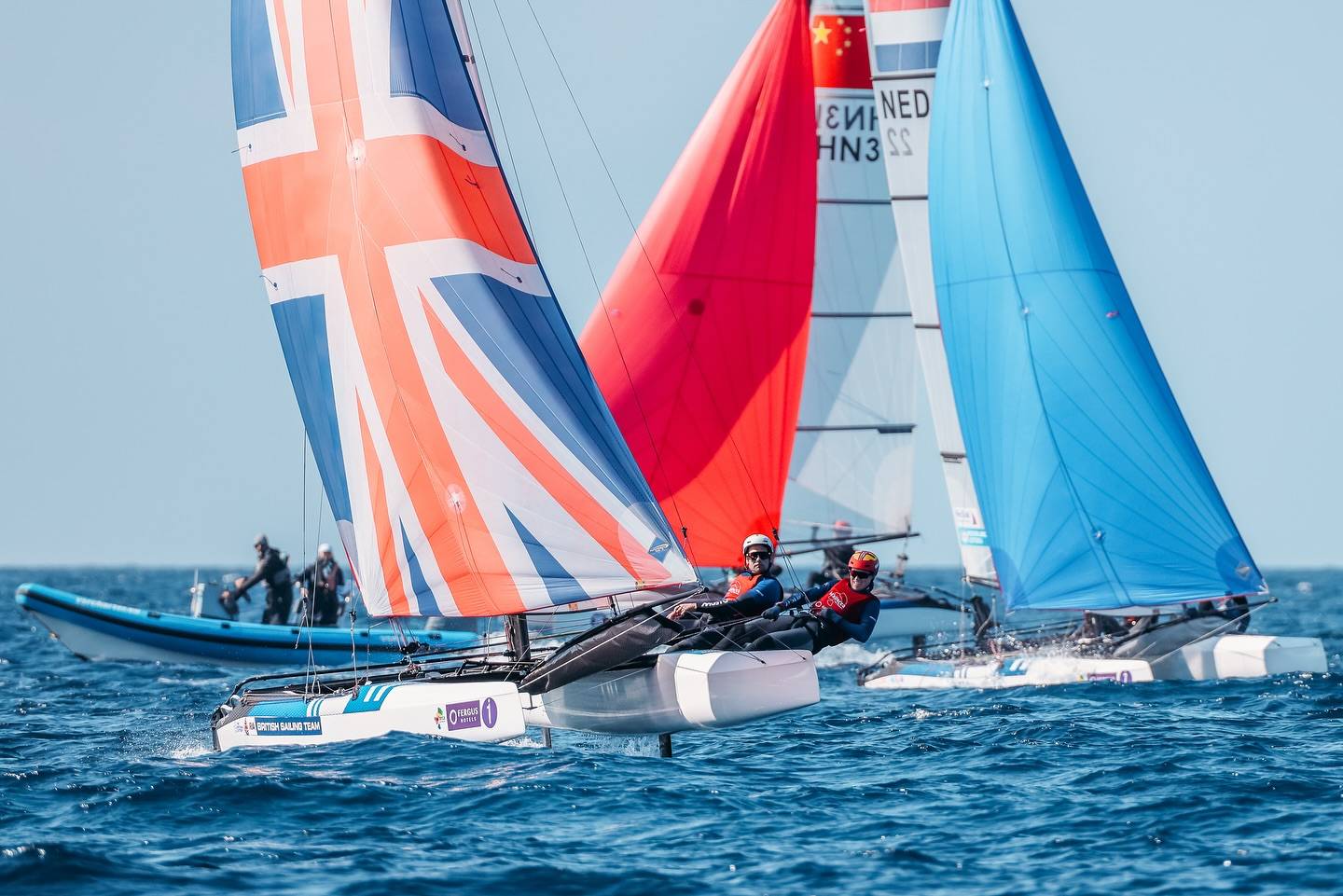A-Class: Exploder A13 Launched
Third generation A-Class for Exploder. I like the lines of this A, and I like better the cost! I have good reference from a third party from their tests in Spain too.
Jakub sent me a mail with a full design/built description and here it is. I Hope they can have a good season bringing more competitive alternatives to the A-Class. Click images for HQ.
Also check the official IACA www.a-cat.org website for information about important Class notification on Rule 3 New Clarifications and other news like Victorian States won by Steve Brayshaw , Vision at the London RYA and more.////
———
By Jakub Kopylowicz – Exploder A13 Exploder.info
At the beginning of February 2013 our new design of an A-class catamaran has reached an important stage of development – test sailing sessions of first prototypes. This is a good occasion to bring it a little wider audience, open the door from the kitchen and share some first impressions of the tests.
Exploder A13 is a project of a new high performance A-class catamaran that was started in the summer of 2012. The precise moment of accession to the design and construction work is difficult to determine, since it is a smooth transition from the previous models such as the Mayfly A-class (2011), and A-class catamaran eX One (2012).
1. Design assumptions, concepts, inspiration and experience.
All the design work was determined by one premise – to create the fastest high performance boat – this question does not really need any translation, however, says nothing specific about the boat itself.
Together with Jack Noetzel we started from identifying what parameters should determine the new boat. First of all, we tried to determine conditions that the boat is supposed to be high performance in (surge, wind power, etc.), taking into account conditions common to regattas (Worlds, Europeans) in last few years.
The conclusion was that the majority of the heats were raced in moderate winds, with wind speed rarely exceeding 18 knots (and if it was over 20, RC often did not decide to run the race), but a lot of races were held in light and very light winds. The consequence of this was the assumption that the boat should aim for moderate winds, in particular with wind force enough to trapeze on downwind courses, while allowing smooth sailing in slightly stronger winds with short waves (often occurs in bay areas where a lot of catamaran regattas are taking place).
From the other hand, optimizing the boat to such conditions could not make it slow in light air what was reflected in the shape of the hull, that couldn’t have radical lines optimized just for achieving high end speeds as case in for example Cirrus R F18 catamaran.
The next step was to analyze the conceptual work of other known structures of A-class catamarans, identify strengths and weaknesses of the structure, and the conditions under which a boat has the best performance. Here once Jacek Noetzel experience proved to be invaluable.
2. Design.
With precisely defined hull parameters and practical experience, we could begin designing the hull shape. An important factor was to determine the position of the boards, which was established experimentally by moving the centerboard case back and forth in the Myfly and eXone. A particular importance here is the correlation between the sails center of effort, the center of buoyancy of the hull and location of the boards, which substantially affect the performance of the boat allowing more better sailing downwind, ease of lifting the hull, ease of tacking, “nosediving”, etc.
With this knowledge we created a digital model of the hull, which iterations were compared with existing structures. Main parameters modified in subsequent versions was the bow and volume distribution and the rocker.
On this basis, we developed the desired digital model of the hull. The next step was milling a 1:10 model of the hull that could be given some final fine-tuning. Improved digital model was processed with CAM software.
3. Model and hull mold
While working on this project we had to make a little upgrade to our workshop, and have a numerical milling machine, that allowed us to create a core of the mold with high precision and lot of time savings.
Milled model after a finishing touch was ready to be scanned for the mold that was heated for a long period of time.
The mold has direct relationship with the technology we have adopted for fabricating of the hull, that hull is bonded in the form, formed, and then the beams are applied – in our opinion, this method guarantees the linearity of the hull and a higher accuracy than bonding halves of the hulls. The hull is symmetrical and one mold can be used to fabricate right and left hull. Side extensions (balcony) is a separate element appended at the end to a finished hull.
Finally, the hull is equipped with a milled aluminum inserts for fixing the centreboard box, flat mainsail rail fixing design, etc. After that the form has been prepared to carry out the hulls.
4. Platform – laminating and production technology.
In carrying out the hulls we used the already proven in the previous catamaran (eXone) lamination technology in reinforcement system. Hulls are made of a honeycomb (honeycomb) 10 mm carbon fiber insert. In order to reduce the weight and increase the rigidity we decided to use the unidirectional fibers in the inner hull plating and local strengthening with carbon fabric.
Beams with a cross-section has a positive impact increasing the stiffness of the structure. Beams are made as sandwich structure, what significantly increases the stability of the wall, without a drastic weight increase, what would be the case of beams with a monolithic structure.
As previously mentioned the basis of the reinforcement is unidirectional carbon fiber, and additionally to increase the stiffness of some elements of the platform, they are reinforced with a high module carbon fiber.
The rigid construction of the platform reduces the dissipated energy what has the effect in higher end speeds of the boat.
Finally hulls are heated and after that the beams are attached. After that the hulls are equipped with fittings and painted.
5. Foils
We decided to equip the boat with a classic C-type boards and rudder blades with optional winglets. This solution is not revolutionary, but proven and having in mind some of experience from our earlier Myfly project it seems to be the most optimal solution for different wind conditions..
– A full flight mode due to A-cat class rules limitations can only be achieved in a relatively
strong wind – above 18 kts. Benefits from flying both hulls is expected only on downwind
courses with wind force over 18 kts which is not common for regattas. In any other
conditions this solution generates only unnecessary drag.
– Foils configuration in case of a full flight mode is different than in case of sailing based on
displacement hull (especially upwind). It is therefore necessary to have additional
adjustment operation of the position of the foil (by changing the foil angle, or partially pulling it up). Adjustment would be necessary at every mark during racing, and these operations are very time-consuming and this does not seem to be feasible on a singlehanded boat, and thus benefits of the full flying mode are consumed by time needed to correctly set the foils on every mark. (Currently, only a few sailors in the world raise the windward board sailing downwind, while none of them does that sailing upwind, while this gives some benefits.
Using a winglet on the ruder boards helps in reducing unwanted pitching of the boat, especially in 2 particular cases – sailing upwind against the waves in light wind and sailing downwind in strong wind.
In the A13 we decided to test different rudder variants –boards without the winglets with different slenderness, a “T” solution (winglets attached to the very tip of the boards) and the “+” type (winglets fitted to the middle section of the board). We focused on testing the “T” solution as in theory it should be the best solution. In order to easily adjust the angle the winglet we designed and manufactured a unique hinge system allowing us to change the angle of the attack of the winglet, without changing the offset od the rudder (no change in the deflection of the board in the rudder).
Foil molds were milled in aluminum, which ensures high dimensional accuracy and foils are made in an autoclave to provide high quality, further reducing their weight.
6. Gear and Accessoires
Designing this boat we tried to ensure the ease and pleasure of sailing, as well as to equip it with items to increase its performance. Thus, for maximum righting force we equipped the hull with a deck extension (balcony). This solution provides additional 2.5 kg af the righting moment, if needed. The very end of the extension from the stern allows the helmsman to place his foot on it and have a good, comfortable and stable position while sailing downwind on the wire.
Rail has been completely leveled with the deck making it easier to move smoothly around the boat. Similarly, centerboards – when fully inserted – they do note protrude from the deck.
7. First sailing
We were able to test our assumptions in early February 2013 in the Spanish Los Alcazares (Mar Manor). We went there with two prototype boats and had some intensive 10 days of testing on the water in wind forces from 4 to over 20 kts.
In the context of the performance we were able to have a comparison to a DNA boat of our colleague, and we are pretty happy with the early results. As maybe we can’t say that the Exploder A13 stands out in speed performance, as the DNA and both A13s, depending on the wind strength hade some advantages – (difference in helms weight was up 20 Kg), but we can say it should be at least as fast as the DNA in various conditions and it surely proved to have lot of naval prowess in strong winds and choppy sea.
We also managed to test the rudders with horizontal winglets in “T” configuration – the first impression is that the boats feels more stable, sways less, and we didn’t observe any disadvantages of this solution on the end speeds. It seems like this should be a good solution, but it requires further testing and comparisons.
In conclusion – at this stage of the project we are very pleased with the results and looking forward to further testing and tuning opportunities which will hopefully be able soon as spring will come to Poland.
The next phase of our project should be tuning and adjusting the boat to achieve settings offering the best performance with some different configuration of the rudders along with testing of some different sails.
A13 Exploder was developed primarily due to own racing aspirations, but possibly it should become a commercially available product. To draw some attention to the new A13, and find a place for the eXploder brand in the market, boats in the initial phase should be offered at a discounted price of € 9,900 (net for the platform). Estimated price (late september) will continue to be attractive at € 12500 netto.
Finally I would like to thank everyone involved in this project, and to all who keep their fingers crossed for us.
Thank you.
Jakub
www.exploder.info
——————–




























Looks very promising!